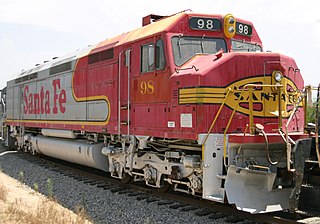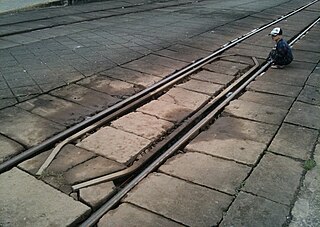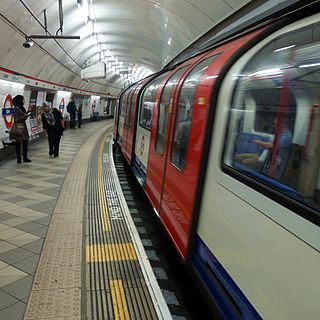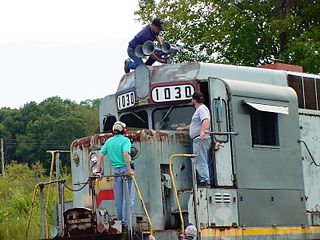 W
WThe Canadian comfort cab or wide cab or North American Safety Cab is a broad-nosed cab design found on modern American diesel locomotives, and some export models. It occupies the entire width of the locomotive, and typically has an access door on the front of the nose. The term wide cab is somewhat of a misnomer because it is the nose, not the cab, that is widened.
 W
WCatch points and trap points are types of turnout which act as railway safety devices. Both work by guiding railway carriages and trucks from a dangerous route onto a separate, safer track. Catch points are used to derail vehicles which are out of control on steep slopes. Trap points are used to protect main railway lines from unauthorised vehicles moving onto them from sidings or branch lines. Either of these track arrangements may lead the vehicles into a sand drag or safety siding, track arrangements which are used to safely stop them after they have left the main tracks.
 W
WThe Confidential Incident Reporting & Analysis Service (CIRAS) is a confidential safety reporting service for health, safety and wellbeing concerns raised by workers in the UK transport industry. It is funded by members and run independently, though is a wholly owned subsidiary of Rail Safety and Standards Board (RSSB). The service covers the following sectors: passenger and freight train operators, light rail, Network Rail and its suppliers, London Underground, and Transport for London (TfL) bus operators.
 W
WA crossbuck is a traffic sign used to indicate a level railway crossing. It is composed of two slats of wood or metal of equal length, fastened together on a pole in a saltire formation. Crossbucks are sometimes supplemented by electrical warnings of flashing lights, a bell, or a gate that descends to block the road and prevent traffic from crossing the tracks.
 W
WA dead man's switch is a switch that is designed to be activated or deactivated if the human operator becomes incapacitated, such as through death, loss of consciousness, or being bodily removed from control. Originally applied to switches on a vehicle or machine, it has since come to be used to describe other intangible uses like in computer software.
 W
WA dead-man's vigilance device is a railroad safety device that operates in the case of incapacitation of the engineer. It is a hybrid between a dead-man's switch and a vigilance control. The main safety failing with the basic dead-man's control system is the possibility of the operating device being permanently held in position, either deliberately or accidentally. The dead-man's vigilance device was developed to detect this condition by requiring that the dead-man's device be released momentarily and re-applied at timed intervals.
 W
WA defect detector is a device used on railroads to detect axle and signal problems in passing trains. The detectors are normally integrated into the tracks and often include sensors to detect several different kinds of problems that could occur. Defect detectors were one of the inventions which enabled American railroads to eliminate the caboose at the rear of the train, as well as various station agents placed along active routes to detect unsafe conditions. The use of defect detectors has since spread overseas to other railroad systems.
 W
WA railway detonator is a coin-sized device that is used as a loud warning signal to train drivers. It is placed on the top of the rail, usually secured with two lead straps, one on each side. When the wheel of the train passes over, it explodes, emitting a loud bang. It was invented in 1841 by English inventor Edward Alfred Cowper.
 W
WA Detrainment device is equipment on a rail vehicle that provides an evacuation route for the passengers. It usually consists of a set of steps or a ramp, located at a doorway, allowing passengers to leave the vehicle in an emergency, vehicle breakdown or accident.
 W
WA driver's reminder appliance (DRA) is a manual switch in the driving cab of a passenger train. When operated it glows bright red and prevents the driver from being able to apply power. It was introduced in the design and operation of United Kingdom passenger trains in the 1990s in response to a series of railway accidents where train drivers had passed a signal at danger when starting away from a station.
 W
WIn rail transport, guard rails or check rails are rails used in the construction of the track, placed parallel to regular running rail to keep the wheels of rolling stock in alignment to prevent derailment. They are generally used along areas of restricted clearance, such as a bridge, trestle, tunnel, or level crossing. They also help to minimize damage to the structure and allow easier post-accident cleanup.
 W
WThe Hancock air whistle was a railroad whistle intended for use on North American diesel locomotives in place of the standard air horn.
 W
WThe Miller Platform was an innovative railroad passenger car platform of the 19th century designed to prevent the hazard of telescoping in railroad collisions. It was named for its U.S. inventor, Ezra L. Miller, who was issued a patent for it on July 24, 1866. The platform was part of an assembly which included a new type of coupler called the Miller Hook which came to replace the older link-and-pin coupler.
 W
WOperation Lifesaver is the largest rail safety organization in the United States. It was founded by the Union Pacific Railroad in the early 1970s.
 W
WPedestrian railroad safety is concerned with the protection of life through regulation, management and technology development of all forms of rail transportation. In the United States there are some 180,000 miles of track. Pedestrian railroad accidents are the leading cause of death on railways. More than 7,200 pedestrians have been killed by trains in the United States since 1997.
 W
WIn railroading, the pilot is the device mounted at the front of a locomotive to deflect obstacles on the track that might otherwise damage or derail it or the train.
 W
WA platform gap is the space between a train car and the edge of the station platform, often created by geometric constraints, historic legacies, or use of partially compatible equipment.
 W
WPlatform gap fillers are movable platform edge extensions at subway or railway stations where the curvature of the platform creates a significant gap between the platform and subway or train car door.
 W
WPlatform screen doors (PSDs), also known as platform edge doors (PEDs), are used at some train or subway stations to separate the platform from train tracks, as well as on some bus rapid transit systems. They are primarily used for passenger safety. They are a relatively new addition to many metro systems around the world, some having been retrofitted to established systems. They are widely used in Asian and European metro systems.
 W
WPointing and calling is a method in occupational safety for avoiding mistakes by pointing at important indicators and verbally calling out their status. It is particularly common on Japanese railways, where it is referred to as shisa kanko (指差喚呼), shisa kakunin kanko (指差確認喚呼) or yubisashi koshō (指差呼称); and in China, where it is called "指差呼唤". Gesturing at and verbalizing these indicators helps with focus. The method was first used by train drivers and is now commonly used in Japanese industry. It is not common in other countries, though it is used in the New York City Subway system and many systems built in Chinese standards, for example Addis Ababa-Djibouti Railway. It is recommended by the Japan Industrial Safety and Health Association, and a part of "Railway Management Regulations" in China.
 W
WPositive train control (PTC) is a system of functional requirements for monitoring and controlling train movements and is a type of train protection system. The term stems from control engineering. The train is only allowed to move in case of positive movement allowance. It generally improves the safety of railway traffic.
 W
WRail inspection is the practice of examining rail tracks for flaws that could lead to catastrophic failures. According to the United States Federal Railroad Administration Office of Safety Analysis, track defects are the second leading cause of accidents on railways in the United States. The leading cause of railway accidents is attributed to human error. The contribution of poor management decisions to rail accidents caused by infrequent or inadequate rail inspection is significant but not reported by the FRA, only the NTSB. Every year, North American railroads spend millions of dollars to inspect the rails for internal and external flaws. Nondestructive testing (NDT) methods are used as preventive measures against track failures and possible derailment.
 W
WThe Rail Safety Improvement Act of 2008 is a United States federal law, enacted by Congress to improve railroad safety. Among its provisions, the most notable was the mandate requiring positive train control (PTC) technology to be installed on most of the US railroad network by 2015. This was spurred by the 2008 Chatsworth train collision the month prior to passage of the act. In October 2015, Congress extended the deadline to 2018.
 W
WThe Safety Appliance Act is a United States federal law that made air brakes and automatic couplers mandatory on all trains in the United States. It was enacted on March 2, 1893, and took effect in 1900, after a seven-year grace period. The act is credited with a sharp drop in accidents on American railroads in the early 20th century.
 W
WRailway surgery was a branch of medical practice that flourished in the 19th and early 20th centuries. It concerned itself with the medical requirements of railway companies. Depending on country, it included some or all of: general practice for railway staff, trauma surgery as a result of accidents on the railways, occupational health and safety, medico-legal activities regarding compensation claims against the company, and occupational testing.
 W
WThe safety of the Mass Rapid Transit (MRT) system in Singapore was questioned by the public after several accidents on the system during the 1980s and 1990s. Most problems have been addressed, and many safety measures are visible to users of the system.
 W
WSifa is a type of deadman's control system used on German-influenced European railways. Although deadman's pedals are commonly used on railways worldwide, Sifa systems are specifically those codified by German Industrial Norms VDE 0119-207-5.
 W
WThe Tiger Stripes colour scheme is a pattern of painting applied to locomotives to improve visibility. It entails painting the whole locomotive bright yellow, and adding diagonal black stripes to the front and back. It is called 'Tiger Stripes' because of its resemblance to the stripes of a tiger.
 W
WA train horn is an extremely loud, powerful air horn that serves as an audible warning device on electric and diesel locomotives, electric or diesel power cars, and in electric and diesel multiple units. The horn's primary purpose is to alert persons and animals to an oncoming train, especially when approaching a level crossing. The horn is also used for acknowledging signals given by railroad employees, such as during switching operations.
 W
WA train inspection system is one of various systems of inspection which are essential to maintain the safe running of rail transport.
 W
WThe Transportation Safety Board of Canada, officially the Canadian Transportation Accident Investigation and Safety Board is the agency of the Government of Canada responsible for advancing transportation safety in Canada. It is accountable to Parliament directly through the President of the Queen’s Privy Council and the Minister of Intergovernmental and Northern Affairs and Internal Trade. The independent agency investigates accidents and makes safety recommendations in four modes of transportation: aviation, rail, marine and pipelines.
 W
WWigwag is the nickname given to a type of railroad grade crossing signal once common in North America, named for the pendulum-like motion it used to signal the approach of a train. It is generally credited to Albert Hunt, a mechanical engineer at Southern California's Pacific Electric (PE) interurban streetcar railroad, who invented it in 1909 for safer railroad grade crossings. The term should not be confused with its usage in Britain, where wigwag is generally used to refer to alternate flashing lights, such as those found at modern level crossings.